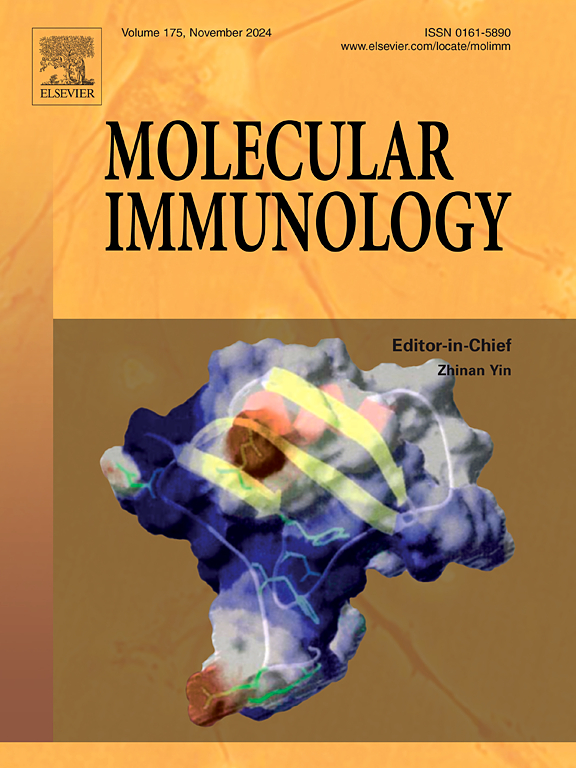SIRT3减轻缺氧缺血性脑损伤后的神经炎症和线粒体损伤
IF 3.2
3区 医学
Q2 BIOCHEMISTRY & MOLECULAR BIOLOGY
引用次数: 0
摘要
目的探讨SIRT3在改善缺氧缺血(HI)所致神经炎症中的作用。方法建立大鼠HI模型,在构建HI模型前48 h,向大鼠脑室注射重组腺相关病毒9型载体。TTC和Nissl染色评价SIRT3对HI大鼠脑梗死和脑萎缩的影响。通过检测IL-1β和MPO阳性细胞和ELISA检测炎症因子来评估神经炎症。同时检测IBA-1、CD68、iNOS阳性小胶质细胞和NLRP3激活相关蛋白的表达。在氧葡萄糖剥夺(OGD)诱导的小胶质细胞模型中,SIRT3过表达,检测细胞形态和促炎细胞因子和NLRP3炎性小体激活相关蛋白的表达。此外,对与过表达sirt3的小胶质细胞共培养的神经元进行线粒体损伤和凋亡分析。结果sirt3可减轻大鼠脑梗死和脑萎缩。它还能抑制神经炎症,减少IL-1β和MPO阳性细胞,降低促炎细胞因子的水平。在HI大鼠模型和OGD细胞模型中,SIRT3均能抑制小胶质细胞和NLRP3炎性体的过度激活。此外,与过表达sirt3的小胶质细胞共培养神经元可减少神经元凋亡,改善线粒体功能,这可以通过降低ROS水平、减轻线粒体去极化和增加ATP生成来证明。结论sirt3抑制炎性小胶质细胞和NLRP3炎性小体,减轻HI脑损伤后的神经炎症。本文章由计算机程序翻译,如有差异,请以英文原文为准。
SIRT3 mitigates neuroinflammation and mitochondrial damage post-hypoxic-ischemic brain injury
Objective
We aimed to explore the role of SIRT3 in ameliorating neuroinflammation caused by hypoxia-ischemia (HI).
Methods
A rat model of HI was established, and 48 hours prior to constructing the HI model, the rats received an intracerebroventricular injection of a recombinant adeno-associated virus type 9 vector. TTC and Nissl staining assessed the effects of SIRT3 on cerebral infarction and brain atrophy in HI rats. Neuroinflammation was evaluated by investigating IL-1β and MPO positive cells, and ELISA for determining inflammatory cytokines. IBA-1, CD68, and iNOS positive microglia and NLRP3 activation-related protein expression were also detected. SIRT3 was overexpressed in oxygen glucose deprivation (OGD)-induced microglia model, where cell morphology and expressions of pro-inflammatory cytokines and NLRP3 inflammasome activation-related proteins were examined. Additionally, neurons co-cultured with SIRT3-overexpressing microglia were analyzed for mitochondrial damage and apoptosis.
Results
SIRT3 alleviated cerebral infarction and atrophy in HI rats. It also inhibited neuroinflammation, reducing IL-1β and MPO positive cells, and lowered the levels of pro-inflammatory cytokines. In both HI rat model and OGD cell model, SIRT3 inhibited excessive activation of microglia and NLRP3 inflammasome. Furthermore, co-culturing neurons with SIRT3-overexpressing microglia resulted in reduced neuronal apoptosis and improved mitochondrial function, evidenced by lower ROS levels, alleviated mitochondrial depolarization and increased ATP production.
Conclusion
SIRT3 restrains pro-inflammatory microglia and NLRP3 inflammasome and alleviates neuroinflammation following HI brain injury.
求助全文
通过发布文献求助,成功后即可免费获取论文全文。
去求助
来源期刊

Molecular immunology
医学-免疫学
CiteScore
6.90
自引率
2.80%
发文量
324
审稿时长
50 days
期刊介绍:
Molecular Immunology publishes original articles, reviews and commentaries on all areas of immunology, with a particular focus on description of cellular, biochemical or genetic mechanisms underlying immunological phenomena. Studies on all model organisms, from invertebrates to humans, are suitable. Examples include, but are not restricted to:
Infection, autoimmunity, transplantation, immunodeficiencies, inflammation and tumor immunology
Mechanisms of induction, regulation and termination of innate and adaptive immunity
Intercellular communication, cooperation and regulation
Intracellular mechanisms of immunity (endocytosis, protein trafficking, pathogen recognition, antigen presentation, etc)
Mechanisms of action of the cells and molecules of the immune system
Structural analysis
Development of the immune system
Comparative immunology and evolution of the immune system
"Omics" studies and bioinformatics
Vaccines, biotechnology and therapeutic manipulation of the immune system (therapeutic antibodies, cytokines, cellular therapies, etc)
Technical developments.
 求助内容:
求助内容: 应助结果提醒方式:
应助结果提醒方式:


